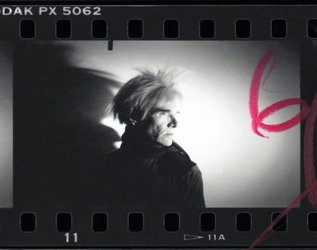Andy Warhol photos on display at the Cantor

Photographs by Andy Warhol that have never publicly been displayed are the heart of the new exhibition, Contact Warhol: Photography Without End, on view Sept. 29, 2018, through Jan. 6, 2019, at the Cantor Arts Center at Stanford University. The show traces Warhol’s artistic process from the most fundamental level of a photo negative to its transformation into his signature silkscreen paintings.

Andy Warhol, “Detail from Contact Sheet [Photo shoot with Andy Warhol with shadow],” 1986. Gift of The Andy Warhol Foundation for the Visual Arts. (Image credit: The Andy Warhol Foundation for the Visual Arts)
“Andy Warhol’s work continues to be some of the most recognizable in the world. However, his photographic work has been much less explored,” said Susan Dackerman, John and Jill Freidenrich Director of the Cantor. “This exhibition allows viewers to see the direct links between the contact sheets and Warhol’s finished works and to understand the importance of photography in the artist’s practice and career.”
The Cantor’s collection of Warhol’s negatives and contact sheets – printed thumbnails from a roll of film – represent the complete range of the American artist’s black-and-white photographic practice from 1976 until his unexpected death in 1987.
This exhibition could not be more relevant, the exhibition curators note, because Warhol’s daily photographic practice for the last eleven years of his life anticipates current daily photographic habits across social media platforms like Instagram and Snapchat, where the “Warhol effect” remains central to contemporary art, culture and everyday life.
Wherever Warhol went during the last decade of his life – whether to discotheques, dinner parties, flea markets or wrestling matches – he brought his 35mm single-reflex camera. Friends, boyfriends, business associates, celebrities and passersby – all captured the artist’s attention. Drawing on a trove of over 130,000 photographic exposures acquired in 2014 from The Andy Warhol Foundation for the Visual Arts, the exhibition brings to life Warhol’s many interactions with the social and celebrity elite of his time. These include Michael Jackson, Liza Minnelli and Dolly Parton; younger sensations in the art world such as Keith Haring and Jean-Michel Basquiat; and political stars, including Nancy Reagan, Maria Shriver and Arnold Schwarzenegger.
“This exhibition allows viewers to experience Warhol’s photography in a depth and detail never before possible,” said co-curator Peggy Phelan, Ann O’Day Maples Professor in the Arts, professor of theater and performance studies and English in the School of Humanities and Sciences and Denning Family Director of the Stanford Arts Institute.
An interactive component of the show includes a touch screen where viewers can browse through the contact sheets, zooming in on images that capture their attention and then create their own virtual prints that will be displayed on a large monitor in the show.
This exhibition allows viewers to experience Warhol’s photography in a depth and detail never before possible.
Peggy Phelan
Co-curator of Warhol exhibit
“This component of the exhibition allows visitors to recapture the intended function of the contact sheets – namely, to look frame by frame at Warhol’s exposures in order to decide which ones are worthy of becoming photographs in their own right,” said co-curator Richard Meyer, Robert and Ruth Halperin Professor in Art History in the School of Humanities and Sciences.
The exhibition also documents the artist’s fascination with the gay culture of the 1970s and ‘80s with photographs of drag queens and parties on Fire Island – a popular escape off of Long Island, New York. The show also includes several of the artist’s rarely seen, sexually explicit images.
In 2014, the Cantor was chosen by The Andy Warhol Foundation for the Visual Arts as the home of Warhol’s extensive archive of negatives and contact sheets. As a university art museum, the Cantor has accessed the Special Collections Department of the Stanford University Libraries (SUL) as well as staff, faculty and students to document the collection and create new scholarship, exhibitions, publications and more on Warhol’s work.
The archive, which includes 3,600 contact sheets, will be available through the Stanford Libraries’ SearchWorks catalog and Spotlight gallery, allowing viewers to zoom in on individual frames. The entire collection of both negatives and contact sheets will also be available on the Cantor website . Cantor archivist Amy DiPasquale oversaw the two-and-a-half-year digitization process.
The collection builds upon the Cantor’s existing collection of Warhol works (from The Andy Warhol Photographic Legacy Program) and reaffirms Stanford’s commitment to continuing scholarship on the history of photography, including the works of Eadweard Muybridge, Carleton Watkins, Robert Frank, Lee Friedlander and others.
The catalog accompanying the exhibition is co-published by the Cantor and MIT Press. In addition to essays by the curators, the volume includes three other scholarly essays and 65 plates.
Please be advised that this exhibition includes some images that may not be appropriate for young viewers.
